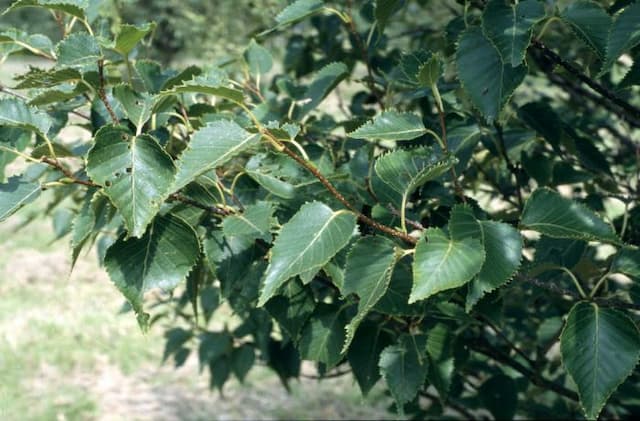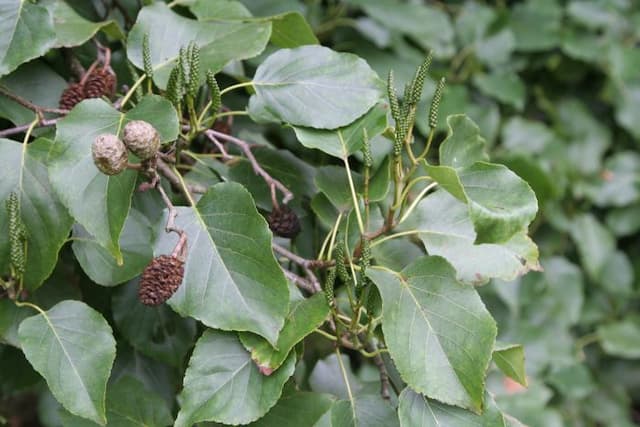Hazelnut Corylus avellana (F)

ABOUT
The plant commonly known as the hazelnut or filbert has a distinct appearance characterized by its rounded leaves, which have a double-serrated edge and a hairy texture on the underside. The leaves grow from the branches in a scattered pattern, contributing to a lush foliage that is a vibrant green color, intensifying to a yellow hue in the fall before they drop. The bark of the hazelnut is smooth and gray-brown, sometimes showing vertical fissures as it ages. During late winter and early spring, the hazelnut produces male flowers in the form of elongated, yellowish catkins that dangle from the twigs. These catkins are quite noticeable as they release pollen into the air. Female flowers are small and red, much less conspicuous, nestled in the buds from which new shoots will grow. After pollination, the female flowers give way to the edible nuts for which the plant is renowned. The nuts are encased in a fibrous husk that partially encloses the smooth, hard shell containing the edible kernel. These distinctive nuts are generally clustered in groups and mature in the fall.
About this plant
 Names
NamesFamily
Betulaceae
Synonyms
European Hazel, Common Hazel, Cobnut, Filbert
Common names
Corylus avellana var. avellana, Corylus avellana subsp. avellana, Corylus avellana var. genuina, Corylus avellana var. pontica, Corylus avellana var. racemosa, Corylus avellana var. rotundata, Corylus avellana var. sylvestris, Corylus sylvestris.
 Toxicity
ToxicityTo humans
Hazel, specifically Corylus avellana, is generally not toxic to humans. In fact, the nuts of the hazel plant, hazelnuts, are widely consumed and appreciated for their taste and nutritional value. However, some individuals may experience allergic reactions to hazelnuts, which can range from mild symptoms such as itching and hives to more severe reactions like anaphylaxis. If a person knows they are allergic to tree nuts, they should avoid consuming hazelnuts.
To pets
Hazel, particularly Corylus avellana, is not typically considered toxic to pets such as dogs and cats. The nuts are not harmful unless consumed in large quantities which may lead to gastrointestinal upset or an intestinal blockage. Nevertheless, as with humans, some pets could potentially have an allergic reaction to hazelnuts or experience difficulty digesting them, especially if they are not a regular part of their diet. It is always best to be cautious and consult with a veterinarian before introducing any new foods into a pet's diet.
 Characteristics
CharacteristicsLife cycle
Perennials
Foliage type
Deciduous
Color of leaves
Green
Height
12-20 feet (3.7-6.1 meters)
Spread
12-15 feet (3.7-4.6 meters)
Plant type
Shrub
Hardiness zones
4-8
Native area
Europe
Benefits
 General Benefits
General Benefits- Nutritional Value: Hazel (Corylus avellana) nuts are rich in vitamins, minerals, and healthy fats, making them a nutritious food source.
- Economic Importance: Hazel nuts are commercially valuable and contribute to the agricultural economy, supporting jobs and industries.
- Wildlife Habitat: Hazelnut bushes provide shelter and food for various wildlife species, including birds and small mammals.
- Edible Landscaping: Hazel plants can be used in edible landscaping, offering both aesthetic value and a source of food.
- Soil Stabilization: The robust root system of hazel plants helps in preventing soil erosion and stabilizing slopes.
- Carbon Sequestration: As a woody plant, hazel contributes to carbon sequestration, helping mitigate climate change.
- Windbreaks: When planted in rows, hazel bushes can act as windbreaks, protecting crops and soil from wind damage.
- Biodiversity Support: Hazelnut orchards can support a diverse ecosystem when managed with sustainable practices.
 Medical Properties
Medical Properties- Astringent: Hazel (Corylus avellana) has been used for its astringent properties, which can help in toning and tightening the skin and mucous membranes.
- Anti-inflammatory: The plant may contain elements that help in reducing inflammation in various parts of the body.
- Vascular protection: Hazel has been traditionally used to support and protect blood vessels, potentially aiding in circulatory health.
- Nutritive: Hazel nuts are rich in nutrients, including vitamins, minerals, and healthy fats, and have been used to support general nutrition and health.
- Skin health: The oil extracted from hazel nuts is sometimes used in skin care products for its moisturizing and potentially skin-regenerating properties.
- Antioxidant: Components within the hazel plant, especially in the nuts, can act as antioxidants, which may help in neutralizing free radicals in the body.
 Air-purifying Qualities
Air-purifying QualitiesThis plant is not specifically known for air purifying qualities.
 Other Uses
Other Uses- Corylus avellana, commonly known as hazelnut, can be used to make natural dyes, with the husks producing a reddish-brown color useful in traditional textile dyeing.
- The flexible branches of the hazelnut tree are strong and can be woven into baskets or used in the crafting of traditional hurdles for agricultural fencing.
- Wood from the hazelnut tree is highly suitable for making walking sticks due to its durability and the pleasing aesthetic of its grain.
- Hazelnut shells have a high calorific value and can be burned in biomass boilers for heating, acting as a renewable source of energy.
- Ground hazelnut shells are used as an abrasive in natural exfoliating scrubs, as a replacement for plastic microbeads in cosmetics.
- The husks and shells of hazelnuts, due to their rough texture, can be used as a natural mulching material that helps suppress weeds and conserve soil moisture.
- As a natural pest control method, hazelnut branches can be used to create habitat piles in gardens, encouraging beneficial insects that control pests.
- The oil derived from hazelnuts is used in wood finishing, as it penetrates well and leaves a protective, nourishing layer on wooden surfaces.
- By practicing coppicing, hazelnuts can be sustainably grown to produce a continuous supply of wood for use in cooking fires and traditional wood ovens.
- Roasted hazelnut shells sometimes serve as a natural odor absorber and can be used in closets or shoes to remove unpleasant smells.
Interesting Facts
 Feng Shui
Feng ShuiThe Hazelnut tree is not used in Feng Shui practice.
 Zodiac Sign Compitability
Zodiac Sign CompitabilityThe Hazelnut tree is not used in astrology practice.
 Plant Symbolism
Plant Symbolism- Protection: Corylus avellana, commonly known as Hazelnut, is often associated with protection due to the ancient belief that hazel trees could ward off evil spirits. Its branches were historically used to make divining rods, which were believed to protect against negative energy.
- Wisdom: Hazelnut trees are linked with wisdom and inspiration. The Celts considered the tree as the symbol of knowledge and wisdom, perhaps because hazelnuts were believed to contain immense insight and were associated with the poetic arts.
- Fertility: With nuts that are both nourishing and abundantly produced, the Hazelnut tree represents fertility and the potential for new life. This symbolism made it a common gift for brides in some cultures.
- Reconciliation: The hazel tree also represents reconciliation. Its branches were traditionally used to make peace with enemies, signifying the mending of disagreements and the restoration of peace.
 Water
WaterFor the Common Hazel, also known as Corylus avellana (F), regular watering is important to keep the soil consistently moist, especially during dry spells. Mature trees should be watered deeply every week with about 15 to 20 gallons of water, allowing for variations depending on rainfall and temperature conditions. During the growing season, increase the frequency to twice a week. Ensure proper drainage to prevent waterlogging, which can lead to root rot. Young saplings may require more frequent watering, around 10 to 15 gallons, two to three times per week, to establish a strong root system.
 Light
LightThe Common Hazel prefers full sun to partial shade. Best growth and nut production occur when the plant receives at least four to six hours of direct sunlight daily. A spot that provides morning sun and some afternoon shade would be ideal, helping to protect the plant from the intense heat of the late day.
 Temperature
TemperatureThe Common Hazel thrives in a range of temperatures, from a winter low of around -20°F to a summer high up to 100°F. They are cold-hardy and can survive brief periods of colder temperatures down to -40°F. The ideal growing temperatures for the Common Hazel fall between 50°F and 75°F.
 Pruning
PruningPruning the Common Hazel is essential for maintaining strong structure, promoting healthy growth, and encouraging fruit production. Prune during the dormant season, late winter or early spring, removing dead or diseased branches, suckers, and any branches that cross or rub against each other. Lightly thin the canopy to allow sunlight to reach the center of the plant. Regular pruning, about once a year, will also rejuvenate older plants and keep them productive.
 Cleaning
CleaningNot needed
 Soil
SoilThe hazelnut, or Corylus avellana, thrives in well-draining, fertile loam soil with a pH of 6.0 to 7.0. A balanced soil mix can consist of garden soil, compost, and sand or perlite to ensure proper drainage and fertility.
 Repotting
RepottingCorylus avellana, commonly known as the hazelnut, typically does not need frequent repotting as it is a large shrub or small tree. It's best to plant it directly in the ground where possible.
 Humidity & Misting
Humidity & MistingHazelnut plants, or Corylus avellana, are adaptable to a wide range of humidity levels and can tolerate the average outdoor humidity in their growing regions.
 Suitable locations
Suitable locationsIndoor
Plant hazelnuts in large pots with drainage, well-draining soil mix, and ample light.
Outdoor
Plant hazelnuts in well-drained soil, full sun, and protect from strong winds.
Hardiness zone
Corylus avellana, or hazelnut, is suitable for USDA zones 4-8.
 Life cycle
Life cycleCommonly known as the common hazel, Corylus avellana (F) begins its life cycle with seed germination, typically in spring, after which a seedling develops. The plant then enters a juvenile vegetative stage, characterized by rapid growth of stems and leaves; during this period, it is establishing a strong root system. After a few years, the plant matures and enters the reproductive phase, producing catkins which are the male flowers, and small red female flowers. These flowers are wind-pollinated, leading to the development of nuts enclosed in a green husk that matures in autumn. After nut maturation, they drop to the ground, completing the cycle as they become a potential source for new seedlings. Throughout its life, Corylus avellana experiences seasonal changes, with active growth in spring and summer, followed by dormancy in winter.
 Propogation
PropogationPropogation time
Late winter to early spring
For the European hazelnut (Corylus avellana), the most popular method of propagation is through seed planting. Seeds should be collected in the fall after they drop naturally from the tree and are then subjected to cold stratification to break dormancy. This process involves mixing the seeds with moist sand or peat and storing them at a temperature of 33-41 degrees Fahrenheit (1-5 degrees Celsius) for approximately 90 to 120 days. After stratification, seeds are sown in well-drained soil at a depth of about 1 to 2 inches (2.54 to 5.08 centimeters), ideally in a nursery bed where they can be tended and monitored for growth. Seedlings usually emerge in the spring and can be grown on for 1 to 2 years before they are large enough to be transplanted to their final location.









